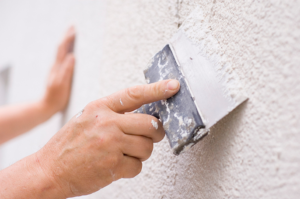Stucco Repair Philadelphia PA is an important service to your clients as it helps maintain their home’s aesthetic integrity and value. While a few cracks are part of normal wear and tear, large cracks and holes may signal more serious problems like foundation settling or water damage.
It’s important to have your stucco repaired by an experienced professional. Inspecting the stucco with a moisture meter can help identify the cause of damage and provide information to your client for remediation.

Water damage to stucco is a common issue many homeowners have to deal with at one point or another. Moisture intrusion into the wall system is not only unsightly. Still, it can lead to some problems for your home, including health-related issues, mold, and even structural damage that may necessitate replacements.
There are a few key things to look for to help you determine whether your stucco has been damaged by moisture. One of the first is water stains that appear on your stucco. These stains will be gray, green, or brown and will likely be visibly obvious on your home’s exterior.
If you notice these stains, it is important to contact a stucco contractor to have them repaired as soon as possible. This will prevent further damage to your stucco and help protect your home from water intrusion in the future.
Another common sign of moisture damage to stucco is mold or mildew. This is usually accompanied by a musty or moldy smell and will also require immediate action. Mold and mildew can have a very negative impact on your family’s health, so it is important to address the problem as quickly as possible.
Other signs of moisture damage to your stucco include leaking around windows or doors and gaps in the caulking. This is a good indication that the window frames and surrounding stucco have been compromised by moisture and should be examined for further damage and possibly replacements.
There are two main factors that influence the cost of a stucco repair or remediation. First, the inspection and moisture testing costs must be factored in. These tests can involve inserting probes into the suspected areas of your stucco to measure the moisture content within the wall system. This is an essential part of determining the cause of any moisture intrusion and can often be done by a certified stucco professional.
Second, the actual cost of repairing or replacing your stucco will depend on the extent of the damage. Stucco repairs are more likely to be cheaper than a full remediation, as they only focus on fixing the surface level of your home’s stucco. Remediation is a much more involved process and will involve addressing any underlying issues that are causing your stucco to fail.
Indentation or Soft Spots
Stucco is a very popular exterior home finishing material and has become a standard feature on many new homes. It is a beautiful and durable material that can stand up to the elements, but it’s important for homeowners to know the warning signs of stucco problems. Some of the most common warning signs include cracking, water damage, and staining. If you notice any of these issues on your home’s stucco walls, it may be time to call a professional to perform a simple stucco repair or complete a more comprehensive stucco remediation.
If you notice cracks on your stucco wall, you’ll want to check the size of those cracks. Hairline cracks are fairly normal and not a significant cause for concern, but cracking that is wider than a quarter of an inch could indicate that there is a serious structural issue with your home’s foundation.
If your home’s stucco has begun to degrade, it can cause the underlying wood to rot. This can lead to a number of different issues for your home, including the need for a complete wood replacement. Another major problem is that rotted wood can create moisture issues, which may lead to further problems with your stucco.
The most obvious sign of a failing stucco finish is cracking. However, you also need to keep an eye out for stains and blistering. Staining can appear as brown streaks under windows or at the intersections of the roof and walls, while blistering is visible when the top layer of the stucco begins to peel away.
In order to repair a cracked or soft spot, you’ll need to use a hammer and chisel to loosen the old stucco. Then, you’ll need to remove the loose sections and clean out the area. Next, you’ll need to mix the appropriate amount of elasomeric or premixed stucco patch per its instructions and fill in the damaged areas. Once the patch has dried (following the recommended dry times), you’ll need to smooth it out using a rubber float and blend it into the existing texture of your stucco.
Cracks or Holes
Stucco is a popular wall-building material for both homes and commercial buildings because of its durability and attractive finish. However, it’s not immune to damage over time from weather and physical impacts. Hairline cracks are common and often easy to fix using joint compound, but larger holes require more comprehensive repair techniques to prevent future water intrusion and further damage.
Whether your stucco is damaged by a small hole or widespread cracks, the first step in repairing them is to remove any loose material from the affected area. Then, clean the void and dampen it slightly to ensure a good bond for the new stucco. Next, use a wire brush to scrub away any remaining debris and dirt that might hinder adhesion, and then scrape off any old flaking stucco with a hammer and chisel, being careful not to damage the surrounding structure.
After cleaning the void and dampening it, you’ll need to apply some fiberglass mesh over the entire surface. Then, you can begin to patch the holes. For smaller holes, you can use a standard caulk gun to apply stucco repair compound directly over the hole. Once the caulk has been applied, use a trowel to smooth it out and match its texture to the surrounding wall finish. Then, allow it to cure for 24 hours before painting it with a water-based paint that matches your home’s exterior color.
For wider cracks, you’ll need to follow a similar process but with the addition of a foam core. The foam is used to create a stronger base and fill the cracks before applying the stucco. This is necessary to ensure that the cracks won’t open up again later and cause more structural damage to your home.
Once the cracks have been filled, you’ll need to apply a second layer of stucco over it to provide additional strength and protection from moisture. When this is done, it’s important to let it cure completely before painting so the elasticity of the foam will not interfere with the ability of the new stucco to hold its own against precipitation.
Remediation
Remediation is more in-depth than a repair and usually involves stripping away all the stucco layers to find the source of the moisture penetration. This is more expensive, and it can take longer than a simple repair, but it’s the best long term solution. It also fixes the problem for good and prevents moisture intrusion from happening again.
If you have a water damage issue, it’s important to have it remedied quickly and thoroughly. Otherwise the moisture can eat through the sheathing and framing, cause rot, and lead to mold growth. Mold is toxic and can exacerbate allergies and other health problems, so removing it as soon as possible is crucial for your family’s well-being. In addition, if left untreated the mold can spread to other parts of the home, such as drywall and ceilings.
Stucco damage is a serious concern, and it can impact the overall value of your home. Whether your stucco is damaged from flooding or simply old and starting to wear down, it’s important to have it inspected and repaired promptly. Doing so will save you money on costly repairs and maintain the integrity of your home’s structure.
One of the biggest signs that your stucco needs remediation is blistering and blooming. This occurs when water seeps through the stucco into a space behind it and becomes trapped. It can then start to rot the sheathing and framing, which could threaten the structural integrity of your home.
Blooming and blistering can be caused by a variety of issues, including improperly installed expansion joints, base coats that are applied before the stucco is fully dry, and poor construction practices. In some cases, a house that is settling faster than expected or seismic activity can lead to blistering and blooming as well.
Stucco repairs are typically much cheaper than remediation, but if you have an underlying issue that needs to be addressed, it may be more economical to pay for the full remediation process. A good professional will be able to advise you on the right service for your home.








